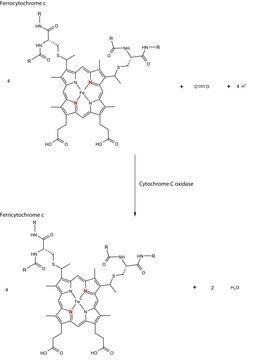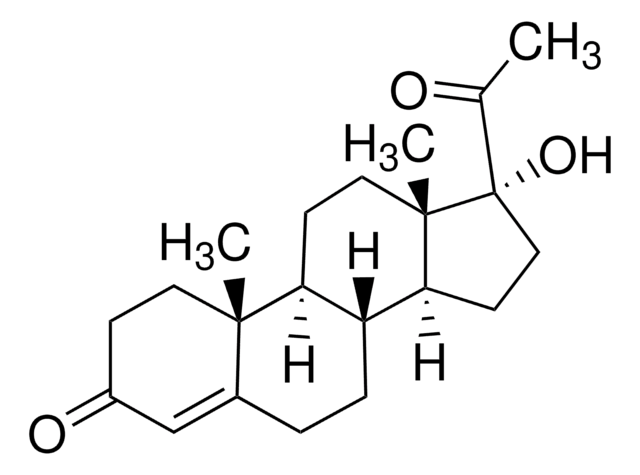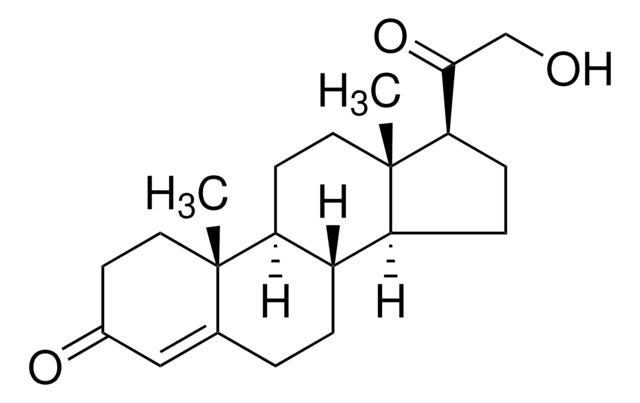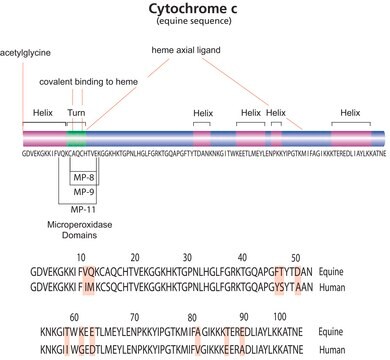QIA87
Cytochrome c Release Apoptosis Assay Kit
Autenticatiper visualizzare i prezzi riservati alla tua organizzazione & contrattuali
About This Item
Codice UNSPSC:
41116133
Prodotti consigliati
impiego
sufficient for 100 tests
Livello qualitativo
Produttore/marchio commerciale
Calbiochem®
Condizioni di stoccaggio
OK to freeze
avoid repeated freeze/thaw cycles
tecniche
immunoblotting: suitable
input
sample type cell extract(s)
Temperatura di conservazione
−20°C
Descrizione generale
Assay kit provides a unique combination of reagents useful for the isolation of a highly enriched mitochondrial fraction from the cytosol. Translocation of cytochrome c from the mitochondrial fraction to the cytosol is monitored by immunoblotting with the cytochrome c antibody provided with the kit.
Componenti
Mitochondria Extraction Buffer, Cytosol Extraction Buffer, Protease Inhibitor Cocktail, Reducing Reagent, Cytochrome c Antibody, and a user protocol.
Attenzione
Toxicity: Multiple Toxicity Values, refer to MSDS (O)
Specifiche
Assay Time: 4 h
Principio
The Cytochrome c Release Apoptosis Assay Kit provides a unique combination of reagents useful for the isolation of a highly enriched mitochondrial fraction from the cytosol that can be used to detect cytochrome c by Western blotting.
Nota sulla preparazione
• 1X Cytosol Extraction Buffer: Prepare 1X Cytosol Extraction Buffer by adding the 20 ml 5X Cytosol Extraction Buffer to 80 ml diH2O; mix well.• Mitochondria Extraction Buffer Mix: Just prior to performing the assay, prepare enough Mitochondria Extraction Buffer Mix for the number of samples to be assayed; each sample requires 0.1 ml of the mix. To prepare 1 ml Mitochondria Extraction Buffer Mix, add 2 µl 500X Protease Inhibitor Cocktail and 1 µl DTT to 1 ml Mitochondria Extraction Buffer; mix well.• Cytosol Extraction Buffer Mix: Just prior to performing the assay, prepare enough Cytosol Buffer Mix for the number of samples to be assayed; each sample requires 1 ml of the mix. To prepare 1 ml Cytosol Extraction Buffer Mix, add 2 µl 500X Protease Inhibitor Cocktail and 1 µl DTT to 1 ml Cytosol Extraction Buffer; mix well.
Stoccaggio e stabilità
Upon arrival store the entire contents of the kit at -20°C. Once opened, store the Mitochondria Extraction Buffer and Cytosol Extraction Buffer at 4°C and the remaining components at -20°C.
Altre note
Due to the nature of the Hazardous Materials in this shipment, additional shipping charges may be applied to your order. Certain sizes may be exempt from the additional hazardous materials shipping charges. Please contact your local sales office for more information regarding these charges.
Note legali
CALBIOCHEM is a registered trademark of Merck KGaA, Darmstadt, Germany
Codice della classe di stoccaggio
8A - Combustible corrosive hazardous materials
Certificati d'analisi (COA)
Cerca il Certificati d'analisi (COA) digitando il numero di lotto/batch corrispondente. I numeri di lotto o di batch sono stampati sull'etichetta dei prodotti dopo la parola ‘Lotto’ o ‘Batch’.
Possiedi già questo prodotto?
I documenti relativi ai prodotti acquistati recentemente sono disponibili nell’Archivio dei documenti.
Syed Suhail Andrabi et al.
Disease models & mechanisms, 10(6), 787-796 (2017-04-02)
Organelle damage and increases in mitochondrial permeabilization are key events in the development of cerebral ischemic tissue injury because they cause both modifications in ATP turnover and cellular apoptosis/necrosis. Early restoration of blood flow and improvement of mitochondrial function might
Yin Liu et al.
Virology, 360(2), 364-375 (2006-12-13)
We previously showed that infection of rat oligodendrocytes by ultraviolet light-inactivated mouse hepatitis virus (MHV) resulted in apoptosis, suggesting that the apoptosis is triggered during cell entry. To further characterize the earliest apoptotic signaling events, here we treated cells with
Role of the mitochondrial signaling pathway in murine coronavirus-induced oligodendrocyte apoptosis.
Yin Liu et al.
Journal of virology, 80(1), 395-403 (2005-12-15)
A previous study demonstrated that infection of rat oligodendrocytes by mouse hepatitis virus (MHV) resulted in apoptosis, which is caspase dependent (Y. Liu, Y. Cai, and X. Zhang, J. Virol. 77:11952-11963, 2003). Here we determined the involvement of the mitochondrial
Gurdeep Marwarha et al.
Biomedicines, 10(1) (2022-01-22)
Apoptotic cell death of cardiomyocytes is a characteristic hallmark of ischemia-reperfusion (I/R) injury. The master hypoxamiR, microRNA-210 (miR-210), is considered the primary driver of the cellular response to hypoxic stress. However, to date, no consensus has emerged with regards to
Il team dei nostri ricercatori vanta grande esperienza in tutte le aree della ricerca quali Life Science, scienza dei materiali, sintesi chimica, cromatografia, discipline analitiche, ecc..
Contatta l'Assistenza Tecnica.






